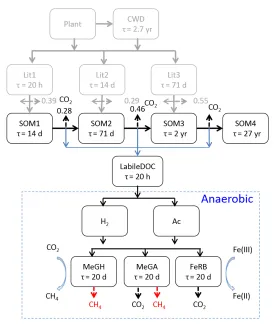Soil organic carbon turnover and CO2 and CH4 production are sensitive to redox potential and pH. However, land surface models typically do not explicitly simulate redox or pH, particularly in the aqueous phase, introducing uncertainty in greenhouse gas predictions. To account for the impact of availability of electron acceptors other than O2 on soil organic matter (SOM) decomposition and methanogenesis, Guoping Tang (ORNL) and others extended an existing decomposition cascade model (the Converging Trophic Cascade model, or CTC) to link complex polymers with simple substrates and add Fe(III) reduction and methanogenesis reactions. Because pH was observed to change substantially in the laboratory incubation tests and in the field and is a sensitive environmental variable for biogeochemical processes, Guoping and his colleagues used the Windermere Humic Aqueous Model (WHAM) to simulate pH buffering by SOM. To account for the speciation of CO2 among gas, aqueous, and solid (adsorbed) phases under varying pH, temperature, and pressure values, as well as the impact on typically measured headspace concentration, these researchers used a geochemical model and an established reaction database to describe observations in anaerobic microcosms incubated at a range of temperatures (-2, +4, and +8 °C). Their results demonstrate the efficacy of using geochemical models to mechanistically represent the soil biogeochemical processes for Earth system models. The modeling approach demonstrated in this work will be evaluated against additional field and laboratory data, and will be incorporated in new Earth system modeling development to improve prediction of greenhouse gas fluxes in Arctic tundra environments.
Reference:
Tang, G., J. Zheng, X, Xu, D.E. Graham, B. Gu, S. Painter, and P.E. Thornton. 2016. Biogeochemical model of CO2 and CH4 production in anoxic Arctic soil microcosms. Biogeosciences Discussion (in review). http://dx.doi.org/10.5194/bg-2016-207
[[{"fid":"190","view_mode":"default","type":"media","link_text":null,"fields":{},"attributes":{"title":"Figure 1. Extension of the CTC decomposition model (Thornton and Rosenbloom, 2005) to include a labile dissolved organic carbon pool (LabileDOC). A portion of the original respiration fraction is assumed to produce labile DOC, which undergoes fermentatio","height":"1177","width":"995","class":"media-element file-default"}}]]
Figure 1. Extension of the CTC decomposition model (Thornton and Rosenbloom, 2005) to include a labile dissolved organic carbon pool (LabileDOC). A portion of the original respiration fraction is assumed to produce labile DOC, which undergoes fermentation, Fe reduction, and methanogenesis to release CO2 and CH4. FeRB, MeGA, and MeGH denote microbial biomass pools for Fe reducers, acetoclastic methanogens, and hydrogenotrophic methanogens, respectively. τ is the turnover time, shown here normalized for 25 °C and ideal moisture and nutrient availability conditions.
Figure 1. Extension of the CTC decomposition model (Thornton and Rosenbloom, 2005) to include a labile dissolved organic carbon pool (LabileDOC). A portion of the original respiration fraction is assumed to produce labile DOC, which undergoes fermentation, Fe reduction, and methanogenesis to releas
For more information, please contact:
Peter Thornton
thorntonpe@ornl.gov

